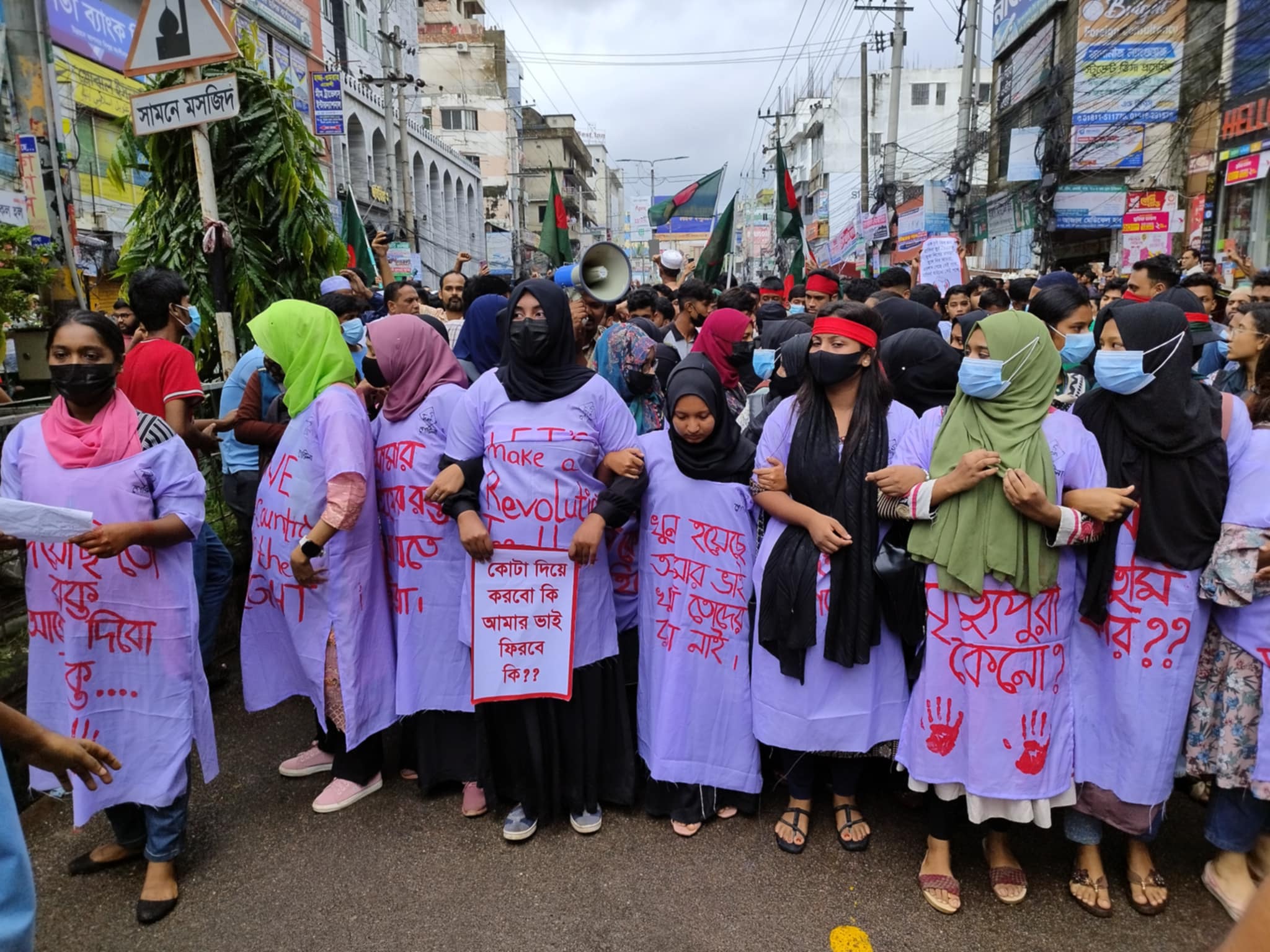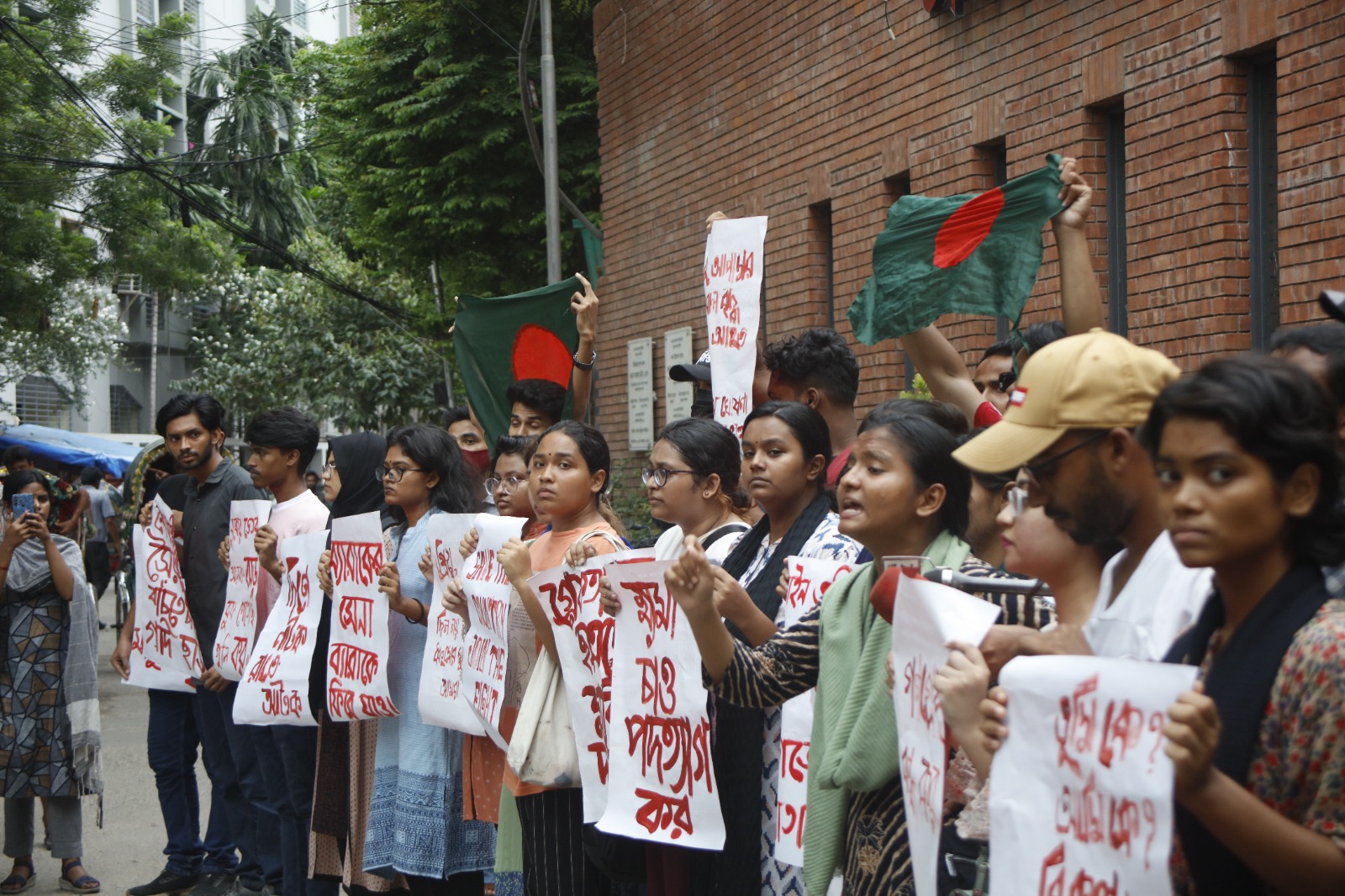Women can no longer afford to wait in the sidelines
Shaveena Anam
There were several images of young women at the forefront of the protests that were symbolic of the resistance in July. A student in glasses, her hands shielding her bloodied face, a lone young woman using her bare hands to stop a police van, an activist boldly calling out the government’s brutality, her hands shaking but not her voice, a group of women wearing white burkhas with slogans written on them, likely to keep their arms free, their garment their tool of protest.
Marching alongside protesters from the Press Club to Shaheed Minar, I saw women of different ages in different attires, in hijabs, sharis or in t-shirts, their voices loud, their rage reverberating through the crowd. I felt inspired by (and maybe even a little envious of) their spirit, their ability to boldly take up their rightful place in the streets. The students were equal comrades here, with the same sense of outrage, same experience of loss, same call for justice. Their energy gave me hope: this generation of women are no pushovers, they are going to bring a change to our social fabric.
But my optimism has since been tested. Following the fall of Sheikh Hasina and the establishment of the interim government, the once powerful voices of women during the revolution are missing in the public sphere. Historically, women’s rights have been deprioritised or postponed in favour of broader societal objectives. In post-revolution Bangladesh, where there have been several worrying incidents involving violence, online harassment and moral policing, we find ourselves in a position where we are having to choose between voicing our concerns, or showing patience.

Female protesters with slogans on their clothes
The organisation and leadership from female students were crucial in advancing the movement. Nusrat Tabassum, Rafia Rehnuma, and Umama Fatema were among the coordinators of the Anti-Discrimination Student Movement. In an interview with The Daily Star, they recounted how they organised and motivated large numbers of women to join. When the Movement launched the “Bangla Blockade,” Dhaka University’s female students took the lead, blocking Shahbagh intersection at varying times each day, allowing for the protests to expand to other locations.
At times when protests would start to thin, women stepped up to fill any gaps and maintain a constant presence. They faced similar levels of brutal treatment as their fellow protesters, including beatings by BCL, narrow escapes from police gunfire, tear gas burns, displacement due to closed university halls, the loss of friends to violence, home raids, and invasive phone checks. On the night of July 16, Rokeya Hall was the first to drive away BCL leaders, inspiring other female dormitories to follow suit. This wave of resistance eventually spread to the male halls. While their bravery shone brightly during the protests, it is starting to feel like their contributions have faded from the narrative.
One of the contentious issues among women during the protests was the women’s quota itself. I was admittedly a little surprised to see many young women go on the record and say they no longer needed a quota for women as women had made such progress in the country. They were seen holding placards with messages like “Where women progress, quotas are ridiculous.” These young, educated women no longer considered themselves as a neglected group.

A student protester holding a sign saying "Where women progress, quotas are ridiculous.
Intersectional feminists would argue that demonising the quota system is problematic and elitist, as urban women do not represent the experiences and obstacles faced by women from marginalised communities or rural households. For many, the quota isn’t a privilege. It helps create a more level playing field, allowing individuals from marginalised groups to access education and job opportunities that might otherwise be out of reach. While many young women publicly opposed the women’s quota, it’s unclear if this sentiment was universally held. When the women’s quota was suddenly abolished, it was difficult to address it amidst the escalating violence and loss of life in July. It was not the time.
With the establishment of the new interim government led by Nobel laureate Muhammad Yunus, we see a cabinet of 16 advisers—only four of whom are women. The two student coordinators chosen for cabinet are male, as well as the three special assistants to the Chief Adviser. Most of the public speeches and plans for reform have come from men. While I believe in all their capabilities, I can’t help but feel a little disappointed at this glaringly unequal representation.
Having four women out of 16 advisers feels more like tokenism when these women are assigned to traditionally “feminised” roles like social welfare and women’s affairs. When some of us voiced our concerns, the responses included, “At least there are four” and “We need to be patient”, so again, this is not the time.
But while we wait, we are witnessing the relentless vilification of women on social media. Women who were hailed as “tigresses” and “queens” in July are now subjected to vicious trolling and harassment. Farzana Sithi, a prominent figure in the student protests, is a prime example. A video of her challenging the police during a protest went viral, earning her widespread praise and admiration. A more recent video of her arguing with an army officer sparked a wave of misogynistic attacks online. Her fiery attitude, once celebrated, was now deemed unladylike, uncivil. The public criticism extended beyond her actions in the videos, with photos from her social media profiles being used to shame her.
Nusrat Tabassum was one of the six protest coordinators who was detained by the DB and coerced into making a statement to withdraw the protest initiatives. After August 5, I started noticing severe online bullying and countless comments criticising her clothing choices (Orna koi?) and tone of voice (Nijeke ki mone kore?). Once a prominent and bold voice, it appears she has largely retreated from the public eye. When discussing this issue of online harassment, some of the protesters say “We are used to it,” which to me is unacceptable. The use of threats and violence to intimidate women out of public life is a common tactic, both here and around the world. This kind of control stifles our voices and limits our ability to participate in leadership and decision-making.

The organisation and leadership from female students were crucial in advancing the movement
If it continues to be socially acceptable to keep punishing women for being assertive, we risk discouraging future generations from stepping up and taking on activism or leadership roles. In the last 15 years, we experienced first hand the cost of waiting in silence. We stayed quiet in the face of many injustices under the illusion of development and progress. The Awami League government was successful in fostering a climate of fear and using the spectre of a far right, conservative political leadership to keep women afraid, disengaged and apolitical. And in our silence, violent oppression thrived.
Now, whenever instances of online harassment or moral policing by men arise, a fear of loss of the progress we made emerges within us. But we can’t give in to those anxieties and neither can we afford to keep waiting. Just as there has been a political awakening among the youth, who are studying history, engaging in discourse around reform, women also need to be more proactive, vocal and politically engaged. Let’s look back at our rich history of women’s movements, let’s come together to critically examine the systemic inequalities that affect us, and let’s be united in calling out the injustices we face. May we never have to look back at those dark times and regret that we were better off then.
Shaveena Anam is manager, New Content and Audience Research at The Daily Star.
Back to Homepage